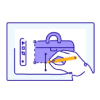Enhance Your Logistics Skills with SAP EWM Online Training
SAP EWM Training || SAP EWM certification Training || SAP EWM Online training || SAP EWM self-paced training || SAP EWM Instructor-Led training
Key Features of Training:
- 40 Hrs Instructor-led Training
- Mock Interview Session
- Project Work & Exercises
- Flexible Schedule
- 24 x 7 Lifetime Support & Access
- Certification and Job Assistance
SAP EWM(Extended Warehouse Management):
SAP EWM stands for SAP Extended Warehouse Management. It is a module of the SAP Supply Chain Management (SCM) software and is designed to manage and optimize warehouse operations. SAP EWM provides real-time visibility into inventory and warehouse operations, helps streamline processes, and improves warehouse efficiency.
Job opportunities:
Promotion opportunities (Salary Hike):
Increased productivity:
Improved decision-making
Gain in-demand skills
What is future of SAP EWM Consultant?
Growing demand
Emerging technologies
Ongoing development of SAP EWM
Career growth
Importance of communication and collaboration
Globalization
Integration with other SAP modules
- Why Choose SAP EWM Online Training
- If you are interested in improving your skills in warehouse management, SAP EWM Online Training is the way to go. Here are some reasons why this training is an excellent choice for you
- Flexibility and Convenience
- With SAP EWM Online Training, you can learn at your own pace. Whether you’re at home, in the office, or on the go, you have access to all course materials online. This flexibility means you can fit your learning around your schedule
- Learn from Industry Experts
- Our trainers at Srijan Institute are experienced professionals who have worked with SAP EWM in real-world settings. They bring their knowledge to the classroom, helping you understand how SAP EWM works and how it can be applied to solve practical business problems
- Gain Practical Experience
- We believe in the power of hands-on learning. That’s why our SAP EWM Training includes real-life case studies, exercises, and simulations. You’ll have plenty of opportunities to practice your skills and get a feel for the software, making sure you’re ready to handle any situation in the workplace
- SAP EWM Certification
- After completing the training, you can take the SAP EWM Certification Exam. This certification proves your knowledge and skills in SAP EWM, making you a more attractive candidate to employers. Certified professionals are often seen as more knowledgeable and capable, giving you a competitive edge in the job market
- SAP EWM Training Course Overview
- Our SAP EWM Online Training covers a wide range of topics to ensure you have a deep understanding of how to use SAP EWM. Below are some of the key modules included in the training
- Overview of warehouse management concepts
- SAP EWM architecture
- Key components and features of SAP EWM
- SAP EWM Configuration
- In this module, you’ll learn how to configure SAP EWM for your business. We cover setting up essential settings and master data, which are crucial for using the system effectively
- Basic configuration steps
- Master data management in SAP EWM
- Integration with other SAP modules
- Warehouse Operations in SAP EWM
- Learn how to manage everyday warehouse operations with SAP EWM. This module covers important processes such as receiving goods, managing inventory, and shipping orders.
- Goods receipt and goods issue processes
- Managing warehouse tasks and transfer orders .
- Inventory management and stock control
- Advanced Warehouse Functions
- Once you have a solid understanding of basic warehouse operations, we dive into more advanced SAP EWM features. This module explores how to optimize your warehouse using advanced tools like slotting and rearrangement
- Slotting and rearranging products for better space utilization
- Monitoring and tracking of warehouse tasks
- SAP EWM Reporting and Analytics
- Knowing how to generate reports and analyze warehouse performance is a key skill for any SAP EWM user. In this module, you’ll learn how to use SAP EWM’s reporting tools to track inventory, manage shipments, and measure performance
- Reporting features in SAP EWM
- Analyzing key performance indicators (KPIs)
- Generating real-time reports for warehouse management
- Preparing for the SAP EWM Certification Exam
- Analyzing key performance indicators (KPIs)
- This module is dedicated to helping you get ready for the SAP EWM Certification Exam. We provide practice exams, tips, and guidelines to ensure you feel confident when taking the test
- Exam format and structure
- Practice questions and mock tests
- Tips for passing the certification exam
- Benefits of SAP EWM Certification
- Achieving SAP EWM certification comes with many benefits, both personally and professionally. Here are just a few reasons why you should consider getting certified
- Career Advancement
- SAP EWM certification can open new doors in your career. It makes you stand out from other professionals who may not have the same expertise in warehouse management. Certified professionals are highly sought after by employers
- Higher Earning Potential
- Certified SAP EWM experts often earn more than their non-certified counterparts. With your certification, you can negotiate a higher salary and enjoy better job opportunities
- Enhanced Skills and Knowledge
- The certification process helps you become an expert in SAP EWM. You’ll learn the latest tools and features, and you’ll be able to apply them in real-world warehouse management scenarios
- Industry Recognition
- SAP is a global leader in enterprise software, and being certified in SAP EWM shows that you have a recognized skill set. Employers value this certification, and it can boost your professional reputation
- How to Prepare for the SAP EWM Certification Exam?
- The SAP EWM certification exam can seem intimidating, but with the right preparation, you can succeed. Here are some tips to help you get ready
- Review All Course Modules
- Make sure you understand each module of the SAP EWM training. The exam will test your knowledge of everything covered in the course, so it’s important to go over the material thoroughly
- Take Practice Exams
- Practice exams are a great way to familiarize yourself with the exam format and question types. They also help you identify areas where you may need more study
- Understand Real-World Applications
- The exam isn’t just about memorizing facts—it’s about applying your knowledge to real-life situations. Focus on understanding how SAP EWM works in different business scenarios
- Join Study Groups
- Joining a study group can help you stay motivated and learn from others. You can discuss difficult topics, share insights, and get feedback from your peers
- Why Choose Srijan Institute for SAP EWM Training
- Srijan Institute is one of the leading providers of SAP EWM Online Training. We offer several advantages that make us stand out from other training centers
- Experienced Trainers
- Our trainers are industry professionals with extensive experience working with SAP EWM. They know the software well and can offer valuable insights into how it’s used in the real world
- Flexible Learning Options
- With SAP EWM Online Training, you can study at your own pace. We offer flexible learning schedules so you can fit the course into your busy life. Plus, you can access course materials anytime, anywhere
- Comprehensive Course Materials
- We provide comprehensive study materials, including recorded videos, reading materials, and quizzes, to ensure you understand every aspect of SAP EWM.
- Affordable Pricing
- Our courses are priced competitively, so you don’t have to break the bank to get a top-notch education. We offer affordable options without compromising on quality
- Certification Assistance
- We provide complete support to help you pass the SAP EWM Certification Exam. From practice exams to tips and guidance, we ensure you’re fully prepared for certification
- Enroll Now in SAP EWM Online Training & Certification at Srijan Institute
- Whether you're new to warehouse management or looking to deepen your expertise, SAP EWM Online Training at Srijan Institute is the perfect choice for you. Our training will give you the skills and knowledge you need to succeed in the world of warehouse management, and our SAP EWM Certification Training will ensure you’re ready to take the exam with confidence
- Join Srijan Institute today and take your career to the next level with SAP EWM! To learn more or enroll, visit the Srijan Institute SAP EWM Course
The fee for SAP EWM (Extended Warehouse Management) training can vary depending on several factors such as the location, duration of the course, training format, and level of expertise. SAP offers various training options for EWM, including instructor-led courses, e-learning courses, and virtual live classrooms.
For More details you can Register
SAP EWM(Extended Warehouse Management) Certification:
SAP EWM Certification is a formal recognition of a person's expertise and knowledge in SAP Extended Warehouse Management (EWM) solution. EWM is an advanced warehouse management system that provides comprehensive support for warehouse operations, inventory management, and distribution processes.
There are three levels of SAP EWM certification: Associate, Professional, and Master. Each level of certification requires candidates to pass a different set of exams that test their knowledge of SAP EWM functionality, configuration, and integration with other SAP modules.
To be eligible for SAP EWM certification, candidates must have a minimum of two years of experience in SAP EWM implementation or support projects. However, SAP recommends that candidates have a minimum of four years of experience in SAP EWM.
The SAP EWM certification exam consists of 80 multiple-choice questions, and candidates have three hours to complete the exam. The passing score for the exam is 63%. The exam can be taken at any of the authorized SAP training centers or testing centers around the world.
SAP EWM(Extended Warehouse Management) Curriculum:
SAP EWM INTRODUCTION AND OVERVIEW
Introduction to ECC – WM
Extended Warehouse Management
Difference Between WMS and EWM
QRFC Connection (Between ECC and EWM) Setup complete SAP EWM
ECC ORGANIZATION STRUCTURE OVERVIEW
Plant, Storage Location, Shipping Point, Shipping Condition, Loading Group.
Mapping Plant/ Storage Location to ECC –> Warehouse
Link ECC –> Warehouse
EWM STRUCTURE
Organizational Units in EWM
Warehouse, Storage Type, Activity Areas
MASTER DATA IN EWM
Master Data Creation
CIF Process Overview
CIF Exercise
Vendor Master –> BP Roles
Customer Master –> BP Roles
Product Master
Bin Master — Create/Change/View
Pack spec Overview
Master Data
TRANSACTION DATA OVERVIEW
Outbound Delivery Flow
Inbound Deliver Flow SAP EWM online, ewm100 pdf,
Linking ECC –> EWM Documents
EWM DOCUMENTS
Inbound Delivery Notification
Inbound & Outbound Delivery
Outbound Delivery Notification
Outbound Delivery Order
Warehouse Order
Warehouse Task
GR AND INBOUND PROCESS
Putaway Process and strategies
Process Oriented Storage Control – POSC
Layout Oriented Storage Control – LOSC
Packing, HU Management, Pack spec
Deconsolidation
VAS
EWM Quality Management
Putaway Strategies:
Fixed Storage Bin
Addition to Existing Stock
General Storage
Empty Storage bin
Near Fixed Picking bin
Pallet Storage
Bulk Storage
GI AND OUTBOUND PROCESS
GI Process and Stock Removal Strategies
Packing Specifications and Condition technique for packing specifications
WOCR
Wave Processing
Replenishment
STOCK REMOVAL STRATEGIES
FIFO
LIFO
SLED
Fixed Storage bin
WAREHOUSE MONITOR
Monitor Overview
Warehouse Management Monitor
Monitor Capabilities
Configuration of Warehouse Monitor
HANDLING UNIT MANAGEMENT
Packaging Materials
Packaging Specifications
During Deliveries
Work centre
WT confirmation
Packing using RF
Deconsolidation using RF
RESOURCE MANAGEMENT
Resource, Resource Type, Resource Group
Assignment of Warehouse Order to Resource
Queue’s
WAVE MANAGEMENT
Wave
Processing of Waves
VALUE ADDED SERVICES
VAS order
GR process with VAS order
GI process with VAS order
Warehouse internal process with VAS order
RFID
Configuration settings for RFID
RFID process in GR and GI process
Auctions in RFID:
Automatic Loading and Unloading with RFID
Automatic Packing with RFID
RFID with Resources
SAP EWM(Extended Warehouse Management) Interview Questions & Answers:
1. What is SAP EWM, and how does it differ from SAP WM?
A: SAP EWM (Extended Warehouse Management) is a software system that manages the flow of goods in a warehouse. It offers more advanced features than SAP WM (Warehouse Management), such as enhanced inventory tracking, yard management, and wave management.
2. What are the different processes in SAP EWM?
A: The processes in SAP EWM include inbound processes, outbound processes, internal processes, and storage processes. Inbound processes deal with receiving and putaway, outbound processes deal with picking and shipping, internal processes deal with transfers between storage bins, and storage processes deal with inventory and space management.
3. What is a delivery document, and how is it used in SAP EWM?
A: A delivery document is a document that contains information about a customer order, including the products that need to be shipped, the quantity of each product, and the delivery date. It is used in SAP EWM to manage the outbound processes, including picking and shipping.
4. What is the difference between inbound and outbound delivery in SAP EWM?
A: Inbound delivery refers to the process of receiving goods into the warehouse, while outbound delivery refers to the process of shipping goods out of the warehouse. Inbound delivery includes activities such as unloading, putaway, and quality inspection, while outbound delivery includes activities such as picking, packing, and shipping.
5. What is a warehouse order, and how is it used in SAP EWM?
A: A warehouse order is a document that contains instructions for the movement of goods within a warehouse. It is used in SAP EWM to manage the storage and retrieval of goods, as well as other warehouse processes such as picking, packing, and shipping.
6. What is the difference between a warehouse task and a warehouse order?
A: A warehouse order is a high-level document that contains instructions for the movement of goods within a warehouse, while a warehouse task is a specific activity within a warehouse order. For example, a warehouse order might contain instructions for picking a certain quantity of a product, while the corresponding warehouse task would be the actual physical picking of the product.
7. What is a handling unit, and how is it used in SAP EWM?
A: A handling unit is a physical unit of goods that is used for storage and transportation within a warehouse. It can contain one or more individual products, and is tracked using a unique identification number. Handling units are used in SAP EWM to simplify the tracking and management of inventory.
8. What is cross-docking, and how is it used in SAP EWM?
A: Cross-docking is a process in which goods are received into a warehouse and immediately shipped out without being stored. It is used in SAP EWM to streamline the inbound and outbound processes, and can help reduce storage costs and improve efficiency.
9. What is the difference between a storage bin and a storage type in SAP EWM?
A: A storage bin is a physical location within a warehouse where goods are stored, while a storage type is a group of storage bins with similar characteristics, such as temperature or weight capacity. Storage types are used in SAP EWM to help manage the storage and retrieval of goods, and to optimize warehouse space.
10. What is the difference between a physical inventory and a cycle count in SAP EWM?
A: A physical inventory is a complete count of all inventory in a warehouse, while a cycle count is a periodic count of a small subset of inventory. Physical inventories are typically performed annually or bi-annually, while cycle counts are performed more frequently to help maintain inventory accuracy.
11. What is the difference between a product and a material in SAP EWM?
A: In SAP EWM, a product is a finished good or a semi-finished good that is ready to be sold or used in production, while a material is any item that is used in the manufacturing process or is part of a finished product. Materials can include raw materials, packaging materials, and spare parts.
12. What is wave management in SAP EWM?
A: Wave management is a process in SAP EWM that groups together multiple warehouse orders or tasks into a single processing wave, which can be executed together to optimize warehouse efficiency. It is used to manage inbound and outbound processes, and can help reduce processing times and increase throughput.
13. What is slotting in SAP EWM?
A: Slotting is a process in SAP EWM that involves the strategic placement of products within a warehouse based on their characteristics, such as size, weight, or demand. It is used to optimize the use of warehouse space and increase efficiency, by ensuring that products are stored in the most appropriate locations.
14. What is the difference between a warehouse task monitor and a warehouse order monitor in SAP EWM?
A: A warehouse task monitor in SAP EWM provides real-time visibility into individual warehouse tasks, such as picking or putaway, while a warehouse order monitor provides visibility into higher-level warehouse orders that contain multiple tasks
15. What is the difference between a replenishment order and a transfer order in SAP EWM?
A: A replenishment order is used to move goods from a bulk storage area to a picking area, in order to ensure that inventory is always available for picking. A transfer order, on the other hand, is used to move goods from one storage bin or storage type to another, in order to optimize space utilization or accommodate changes in demand.
16. What is a warehouse monitor in SAP EWM?
A: A warehouse monitor is a tool in SAP EWM that provides real-time visibility into warehouse operations, including inventory levels, order status, and employee productivity. It can be used to identify potential bottlenecks, monitor key performance indicators, and make informed decisions about warehouse operations.
17. What is a slotting strategy in SAP EWM?
A: A slotting strategy in SAP EWM is a set of guidelines or rules that govern the placement of products within a warehouse. It can take into account factors such as product size, weight, demand, and turnover rate, and can help ensure that products are stored in the most efficient and effective manner.
18. What is the difference between a storage unit and a storage bin in SAP EWM?
A: A storage unit is a logical grouping of storage bins, such as a shelf or a pallet, that is used to track inventory. A storage bin, on the other hand, is a physical location within a warehouse where goods are stored. Storage units are used in SAP EWM to simplify inventory tracking and management.
19. What is the difference between a picking area and a bulk storage area in SAP EWM?
A: A picking area is a section of a warehouse where products are stored in a way that makes them easy to access and retrieve for picking, while a bulk storage area is a section of a warehouse where products are stored in large quantities, often on pallets or in bins. Picking areas are typically located close to the shipping area, while bulk storage areas are used to optimize warehouse space.
20. What is the difference between a stock type and a stock category in SAP EWM?
A: A stock type in SAP EWM is a classification that is used to define the status of inventory, such as unrestricted stock, blocked stock, or quality inspection stock. A stock category, on the other hand, is a grouping of stock types that is used to define the material flow within a warehouse, such as inbound, outbound, or internal movements.
Participants will have 24/7 access to our online lab, providing hands-on experience with SAP MM tools and scenarios.
This includes server access to S/4 HANA 2023 for 1 year, ensuring you have ample time to practice and apply your skills in a real-world environment.
With this extended access, you can work on projects, explore advanced features, and solidify your understanding of SAP EWM in the latest SAP S/4 HANA version.














